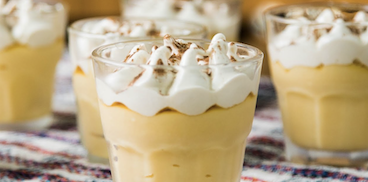Interesting and fun facts
Peru has a lot of interesting stories about the history and background for basically everything. Name it, and we have it. Have a good read!
Peru has a lot of interesting stories about the history and background for basically everything. Name it, and we have it. Have a good read!
All around the world Peru is acknowledged for her gastronomic achievements. Nowadays, children don't dream of becoming a football player, but of becoming a chef instead.
For eight consecutive years, Peru has won the prize for World’s Best Culinary Destination (WTA) organised by the World Travel Awards. The WTA is a renowned institute that serves to acknowledge, reward and celebrate excellence across all sectors of the global travel and tourism industry.
There are about 50 species of corn, 2,000 varieties in potatoes, 650 species of fruit and so on. The cuisine is considered one of the most diverse in the world and is being recognised for its sophisticated flavours. There are three influences for this great diversity: a unique geography, a blend of races and cultures, and the incorporation of ancient cuisine into modern Peruvian cuisine. Thanks to its pre-Incas and Inca heritage and to Spanish, Basque, African, Sino-Cantonese, Japanese and finally French and Italian immigration (mainly throughout the 19th century), Peruvian cuisine combines the flavors of four continents. The ingredients and techniques of each of these culinary traditions have left a clear mark through time on the basic Inca diet, which primarily existed of corn, potatoes, ají and beans. The result of this 'fusion' of cuisines is a vast and colourful range of dishes, each telling it's own story.
Peruvian Pisco won over 20 gold medals and was named the best liquor of the world in the Concours Mondial de Bruxelles.
Annually, the world’s 50 best restaurants are ranked. In 2019, Peru scored really well again on the list. The top 10 includes two restaurants in Lima. At #6, Central by Virgilio Martinez (Central Restaurante, Mil), and at #10 Maido by Mitsuharu Tsumura. Both restaurants also are ranked #1 and #2 on the list of best restaurants of Latin America 2019.
Gastón Acurio is recipient of The World’s 50 Best Restaurants Diners Club Lifetime Achievement Award 2018. He is chef, cooking book author, business man and world's premier ambassador of the Peruvian cuisine as he put it on the world map with the culinary festival Mistura and his collaboration with Ferran Adrià. He has been awarded internationally as the "Entrepreneur of the Year" and owns several chains or restaurants all over the world (Astrid&Gaston Casa Moreyra, Cebicheria la Mar, Tanta, Panchita, Papacho's, Madam Tusan, Chicha, Barra Chalaca, El Bodegón). He is the founder father of Pachacútec Culinary Institute where he trains underprivileged students to become a cook. The school provides classes covering the history of Peruvian cuisine, kitchen techniques, nutrition, and English language. They also learn from great masters of Peruvian cuisine, who are guest teachers at the school.
A list of famous deceased maestro chefs in Peru: Nisei Humberto Sato (Costanera 700, he was one of the first Nikkei chefs), Teresa Izquierdo (El Rincón que no Conoces), Toshiro Konishi (Toshiro’s and Wako, he was a Nikkei pioneer and came to peru to work with Nobu). They all received life-time achievement awards.
A list of nowadays famous chefs: Anthony Vazquez (chef La Mar in Lima, San Francisco and Argentina), Flavio Solorzano (El Señorío de Sulco and he is the founder of festival Mistura), Giancomo Bocchio (Wallqa Restaurante), Hectór Solís (Fiesta), Jaime Pesaque (Mayta), Javier Ampuero (Limeño, Ampuero Cocina Bar), Javier Wong (Chez Wong), José Andrés (World Central Kitchen), José de Castillo (la Isolina), Luis Armando "Cucho' la Rosa (La Casa de Don Cucho), Pedro Miguel Schiaffino (Malabar and M/V Aqua, he is famous as the jungle chef), Palmiro Ocampo (Huevón), Rafael Osterling (Rafael, El Mercado, Felix Brasserie), Rafael Piqueras (Maras), Renato Peralta (Eggo Bread & Breakfast), Teresa Ocampo (Donde Teresa, she is the first TV chef), Tomás Matsufuji (Al Toke Pez).
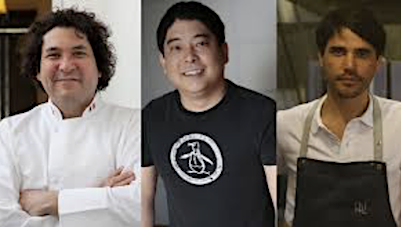
In memory the best cevichero in the world: Pedro Solari (1922-2020). He is considered as the father of the modern ceviche. When he was only twelve years old, his mother was running behind in preparing a lunch for guests, so he offered to make the ceviche. At the time, ceviche was marinated for hours or a day. But the guests already were arriving, so Pedro threw together fish, lime juice, ají limo, onions and salt, left it to marinate and served it five minutes later. Everyone was blown away and unintentionally he had invented modern ceviche. For more than eighty years, Pedro prepared each bowl of ceviche in his cevicheria in Lima. Being a pioneer in the gastronomy of Peru long before Peru was recognised as a culinary country, he received many Peruvian presidents and other celebrities in his restaurant. He taught many famous chefs how to make proper ceviche, such as Javier Wong and Toshiri Konishi. His famous words “Whoever hasn’t eaten my food, is screwed”. May Pedro rest in peace.

For current Peruvian chefs, cooking is a social gastronomic revolution. Not even twenty years ago, Peru was still reeling from the political violence that hit the country in the '80s and '90s. Bombings, food shortages, unsafe situations and power outages occurred on a regular basis. Peruvians didn't love their identity, because there was not much reason to. Today, Peru has risen from chaos and terror to one of the world’s leading culinary destinations.
The beginning of this century when the situation became more safe and at the same time internet began connecting the world, the realisation came that there was not a joint Peruvian identity to rebuild the society. Gastón Acurio already was very powerful in the media and he brought everybody who was involved in gastronomy together. His mission was to jointly investigate and analyse what Peru really was. As the frontrunner he used food as a vehicle to connect the diverse ethnic groups, Chinese, Japanese, Europeans, people from the Andes and people from the jungle. This resulted in a food movement which led to a gastronomic revolution with social change as the aim. The Peruvian cuisine became the driver for development on the road to inclusion, peace and prosperity in a country that had been divided by colonialism, racism, war and terror. He made Peruvians and the whole world fall in love again with their country.
No country is more gastro-political than contemporary Peru, where nowadays hundreds of culinary schools have trained over 80,000 Peruvian chefs, and where one celebrity chef is considered a strong candidate for president. Before, there were no products from the Amazon or the Andes besides some potatoes. Everything was from Lima. At Lima’s central market in Surquillo, a regular destination for the city’s best chefs, one wouldn’t find a diversity of products and ingredients. Today, there's an abundance of goods, from colourful piles of olluco potatoes and golden berries to multiple varieties of quinoa and bags of Maras salt from the Andean highlands.
It is important to realise where we come from as a nation and that the status of one of the world’s leading culinary destinations is not a given. Peru had to work very hard, and still does, and we are extra proud of this.
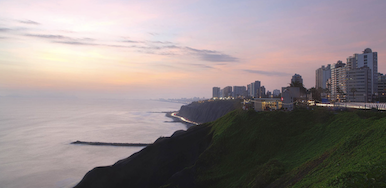
There are so many beautiful stories of dishes emerged in times of war, poverty, fusion or just creativity. Here I intend to build a library of these wonderful stories.
This 'satay skewers' are traditionally made of beef-heart, marinated in vinegar and spices and cooked over flames . Back in the days dismissed by the Spanish Conquistadores as inferior food for the slaves. Nowadays a delicacy for everyone. When the slaves moved to Lima, in the evening the wives went out to sell the on charcoal grilled marinated skewers. The marinade existed of herbs and ingredients they could find. Nowadays the beef heart also can be replaced by squid, chicken or fresh cheese.

During the Salpeter War in 1879, the Peruvian army had trouble getting food 😯 So the Peruvian Mums collected potatoes and other ingredients and created a meal they offered to their soldier sons “for the cause” of defending their territory...and la causa was born. Causa Limeña is a little pie with yellow potato with ají amarillo, avocado, chicken with mayonaise and cilantro. The chicken also can be replaced by tune, squid or beetroot. See there recipe here!

With the economical crisis in the 80s and 90s, street vendors started selling this ceviche from wheelbarrows, "carretilla's". The ceviche was made with fish of an affordable price, so the ceviches could be sold for a reasonable price. The carretillero became very popular and although you nowadays also can eat the ceviche in restaurants, it kept its name. This dish distinguishes itself from the ceviche clásico as it besides fish has "chicharrón", fried squid, and the tiger's milk always contains ginger, celery and garlic. The great thing is that the street vendors prepare it quick and dirty while you are waiting. See the recipe here.
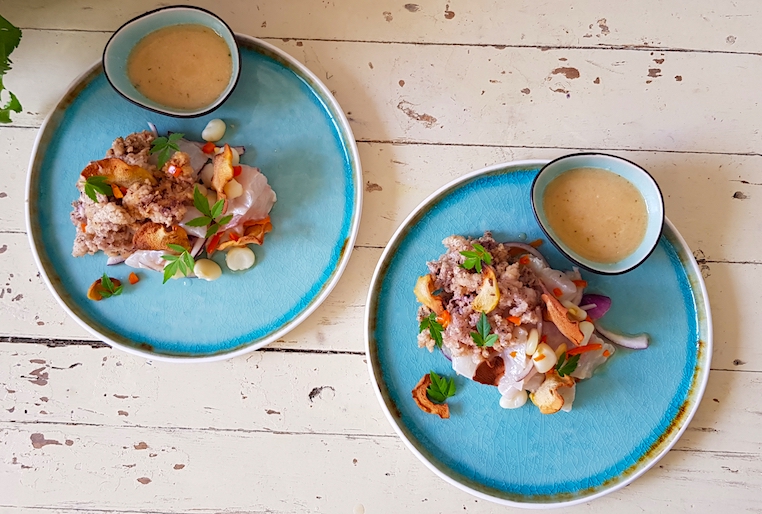
Before independence from Spain, empanadas already were very popular. The Inca king even would perform as judge in empanada contests. Contestants came from bakeries, pastry shops, and cloistered convents to Lima to compete to with the prize for the best empanada. These empanada challenges were held around the feasts of Christmas. During the decade of the nineties empanadas became very popular. People began to sell them from baskets and carts in the streets.
Nowadays, the empanada has become more sophisticated, thanks to the imagination of our great chefs. They set the trend of filling empanadas with the best Peruvian dishes, such as duck seco, rice with chicken, pork adobo, aji de gallina, sangresita, chicharrón, anticuchos, and many more. See the recipe for a lovely empanada with filling of papa rellena.
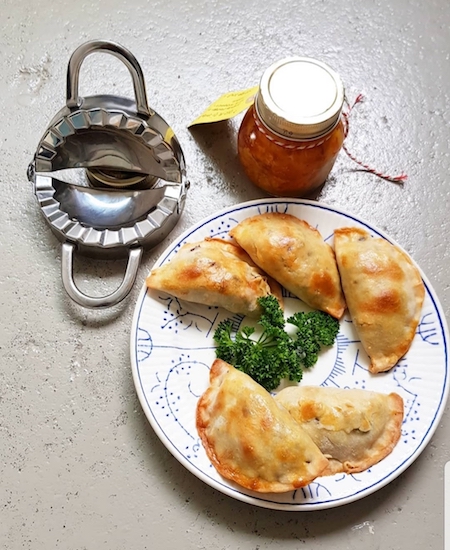
There are several stories about the origin of Papa a la Huancaína, of which the following are the most well-known: during the construction of Peru's Central Railroad from Lima to Huancayo, this was the food for the rail workers. Boiled potatoes were served with a delicious cheese, pepper and milk sauce. Another story explains that the plate was sold to passengers at the railway stations between Lima and Huancayo. From that came the name “potatoes that you eat en route to Huancayo” which later became "Papa a la Huancaína". One thing we do know: the birth of this plate was in the 19th century. See my recipe here!

During the Salpeter War in 1879, the soldiers needed to march long distances and they had to carry pre-made food. As there was no easy way to preserve it, they would cook beef wrapped in dough of cooked potatoes which they then fried. The fried stuffed potatoes they wrapped in stretches of cloth and when mealtime arrived they just pulled back the wraps and ate the stuffed potatoes. The filling nowadays exists of minced beef, egg, raisins, olives, onion and parsley.
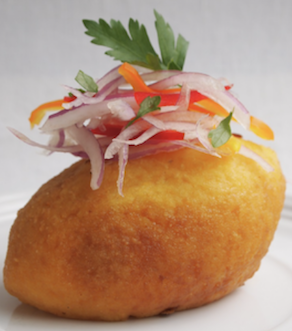
This dish was born in 1987 when a guest of a Peruvian-Japanese restaurant in Lima one night ate at the restaurant. The guest told the owner that he had tried an octopus dish with a lead coloured sauce and he was curious whether she knew the dish. She didn't,, but was curious enough to start experimenting and she came up with a new signature dish: pulpo al olivo, which is an octopus dish with an olive based 'lead coloured' sauce. See the full recipe in my youtube video's.
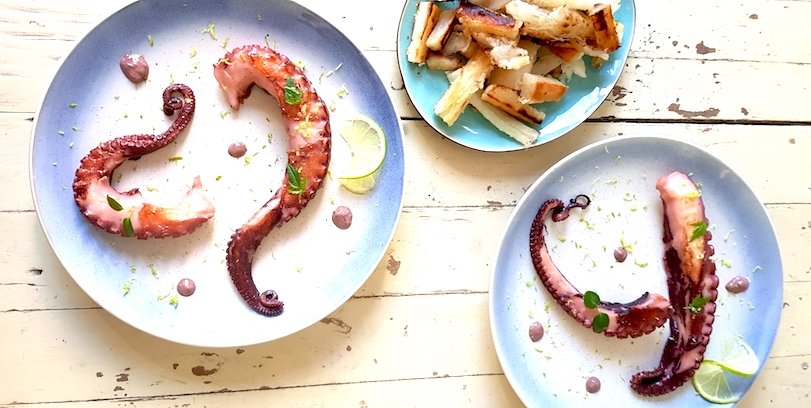
This dessert was born in the 19th century. The wife of a poet invented the recipe and called the dessert 'the sigh of a lady from Lima' because it is super sweet and light. It is made of dulche de leche, merengue with egg yolk, white port and cinnamon. .
